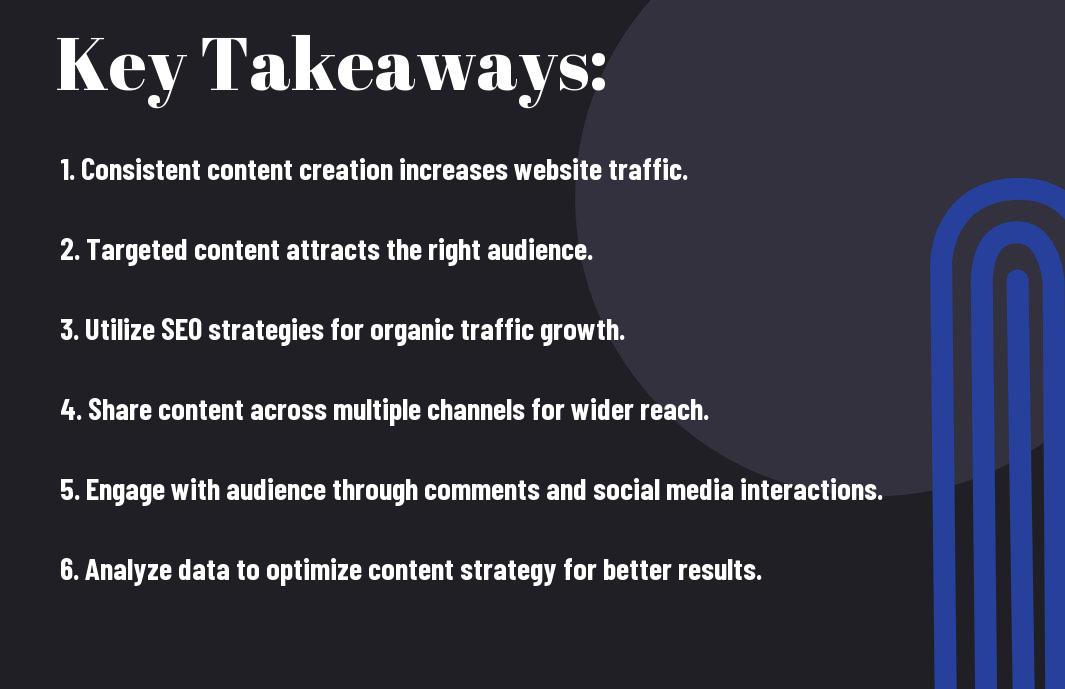With content marketing, you can significantly increase your website traffic. In this case study, you’ll discover how creating A Case Study on How Creating Content Increase Website Traffic can boost your online visibility and attract more visitors. Let’s explore the strategies that can help you achieve remarkable results through content marketing.

Key Takeaways:
- Consistent and high-quality content is crucial for increasing website traffic.
- Utilizing SEO strategies, such as keyword research and on-page optimization, can help improve search engine rankings.
- Promoting content through various channels, such as social media and email newsletters, can attract a larger audience to the website.
The Challenge
Identifying the Problem
To boost your website traffic, the first step is to identify the problem areas that are causing low traffic numbers. This could include outdated content, lack of SEO optimization, or ineffective promotion strategies. Understanding the root cause is crucial in coming up with a targeted content marketing plan to address these issues.
Current State of Website Traffic
State of your website traffic might show low organic search rankings, high bounce rates, and minimal social media engagement. This indicates that potential visitors are not finding your website easily, and even when they do, they are not staying long or interacting with your content.
The current state of website traffic is a critical aspect to consider when devising a content marketing strategy. By analyzing your traffic sources, popular pages, and user behavior, you can uncover valuable insights that will guide your efforts in increasing website traffic.

Content Marketing Strategy
It doesn’t matter how good your content is if it’s not reaching the right people. Defining your target audience is crucial for the success of your content marketing strategy.
Defining Target Audience
On your website, analyze the demographics, interests, and online behavior of your current audience. Use tools like Google Analytics or social media insights to gather data on who is visiting your site and engaging with your content. This information will help you tailor your content to meet the needs and interests of your target audience.
Developing a Content Calendar
Target consistency in your content marketing efforts by developing a content calendar. On a content calendar, you can plan out your upcoming blog posts, social media updates, videos, and more. This helps you stay organized and ensures you are consistently putting out content that resonates with your audience. The content calendar should outline the topics, posting dates, and platforms where the content will be shared.
The key to developing a successful content calendar is to align your content with your business goals and the interests of your audience. By planning ahead and scheduling your content releases, you can stay ahead of the curve and maintain a consistent presence online.
Creating Engaging Content
Creating content that captures and maintains your audience’s attention is vital for driving website traffic. Engaging content is informative, entertaining, and relevant to your target audience’s interests. It should be visually appealing and easy to digest, whether it’s a blog post, video, infographic, or social media update.
Creating a mix of different types of content keeps your audience engaged and coming back for more. By incorporating storytelling, visuals, and interactive elements into your content, you can create a memorable experience for your audience. Content that evokes emotion, prompts action, or solves a problem for your audience is more likely to be shared and drive traffic to your website.
Content Creation and Distribution
Blog Posts and Articles
Content: Unlike traditional advertising, blog posts and articles provide value to your audience by offering useful information, insights, and solutions to their problems. By consistently updating your website with fresh, relevant content, you can establish your authority in your industry and attract more visitors to your site who are seeking valuable information.
Social Media and Email Newsletters
Media: Social media platforms and email newsletters serve as powerful distribution channels for your content. By sharing your blog posts, articles, and other valuable content on social media and through email newsletters, you can reach a wider audience and drive traffic back to your website. You can also engage with your audience, build relationships, and encourage them to share your content with their networks.
Posts: You can use social media to promote your blog posts, articles, and other content, driving traffic back to your website. Email newsletters are a great way to stay in touch with your audience, provide them with valuable content, and keep them informed about your latest offerings.
Guest Blogging and Influencer Partnerships
Email: Collaborating with influencers and guest blogging on established websites in your industry can help you expand your reach and attract new visitors to your site. By partnering with influencers who have a large and engaged following, you can leverage their credibility and authority to increase your own visibility and drive more traffic to your website.
Another: Partnering with influencers and guest blogging on reputable sites can not only boost your website traffic but also enhance your brand’s reputation and credibility in the eyes of your target audience. By creating valuable content and distributing it through various channels, you can position yourself as a trusted resource and attract more visitors to your site.
SEO Optimization
For successful content marketing, SEO optimization is vital to ensure your website ranks higher on search engine result pages. This chapter will guide you through the key strategies to boost your online visibility and drive more traffic to your site.
Keyword Research and Analysis
To start, conducting thorough keyword research and analysis is crucial. Identify relevant keywords and phrases that your target audience is likely to use when searching for content related to your business. Utilize tools like Google Keyword Planner, SEMrush, or Ahrefs to discover high-volume, low-competition keywords to incorporate into your content.
On-Page Optimization Techniques
On-page optimization techniques play a critical role in improving your website’s search engine ranking. Ensure that your title tags, meta descriptions, and headings include your chosen keywords. Optimize your content by incorporating relevant keywords naturally throughout the text, and pay attention to factors like internal linking, image alt text, and URL structure. These techniques help search engines better understand the content of your site and improve its visibility to potential visitors.
On-page optimization is about making your website search engine friendly. By implementing these techniques, you can improve your site’s visibility, attract more organic traffic, and enhance the overall user experience.
Building High-Quality Backlinks
Research shows that building high-quality backlinks is a powerful strategy to improve your website’s SEO performance. Backlinks from authoritative websites signal to search engines that your content is reputable and trustworthy. Focus on creating valuable, shareable content that helps attract natural backlinks from other sites in your industry.
Keyword-rich anchor texts from reputable websites can significantly boost your search engine rankings. Bear in mind, quality over quantity is key when it comes to backlinks. Avoid spammy tactics that could harm your site’s reputation and instead focus on building organic, relevant backlinks that will benefit your SEO efforts in the long run.
Measuring Success
Once again, measuring the success of your content marketing efforts is crucial to understanding the impact of your strategies. Setting clear Key Performance Indicators (KPIs) will help you track the effectiveness of your campaigns and inform future decisions.
Setting Key Performance Indicators (KPIs)
An imperative step in measuring the success of your content marketing is establishing relevant KPIs. These could include metrics such as website traffic, conversion rates, social media engagement, and lead generation. By setting KPIs at the beginning of your campaign, you provide a benchmark to measure against and ensure your efforts are aligned with your objectives.
Tracking Website Analytics
Tracking website analytics is a fundamental aspect of measuring the success of your content marketing strategy. By utilizing tools like Google Analytics, you can monitor important metrics like website traffic, bounce rates, popular pages, and conversion rates. This data provides valuable insights into how users are interacting with your content and where improvements can be made.
This information is imperative for understanding which types of content resonate most with your audience and which channels are driving the most traffic to your site. By tracking these metrics regularly, you can optimize your content strategy for better results.
Monitoring Social Media Engagement
Engagement on social media platforms is a key indicator of the success of your content marketing efforts. Monitoring metrics such as likes, shares, comments, and click-through rates can provide valuable feedback on the effectiveness of your content and the level of audience engagement.
Another important aspect of monitoring social media engagement is analyzing the demographics and behaviors of your followers. By understanding who is engaging with your content and how they are interacting with it, you can tailor your strategies to better meet their needs and preferences. This targeted approach can lead to increased brand awareness and loyalty.
Overcoming Obstacles
Addressing Content Quality Issues
To maximize the effectiveness of your content marketing efforts, it’s crucial to maintain high standards of quality across all your published material. Consistently creating valuable and engaging content that resonates with your target audience is crucial for driving traffic to your website. If you’re facing challenges related to content quality, consider conducting regular content audits to identify areas for improvement and ensure that your content is relevant, up-to-date, and well-researched.
Managing Content Creation Workflow
To streamline your content creation process and maintain a consistent publishing schedule, establish a structured workflow that outlines each step of the content creation process, from ideation to publication. Implementing a content calendar can help you plan ahead, assign tasks to team members, and track the progress of your content projects. By defining roles and responsibilities within your team, you can ensure that deadlines are met and that your content meets the desired quality standards.
The key to successfully managing your content creation workflow is to leverage project management tools that allow for easy collaboration and communication among team members. Utilizing platforms like Trello, Asana, or Monday.com can help you stay organized, prioritize tasks, and monitor the status of each content piece in real-time.
Dealing with Algorithm Changes
With search engine algorithms constantly evolving, staying ahead of the game and adapting your content strategy to meet the latest requirements is crucial for maintaining your website traffic. Keep abreast of algorithm updates from major search engines like Google and adjust your content optimization techniques accordingly to ensure that your content remains visible and ranks well in search results.
Issues may arise when your website’s traffic takes a hit due to sudden changes in search engine algorithms. By analyzing the impact of these changes on your website’s performance, you can devise a strategy to recover lost traffic and mitigate the effects of algorithm updates on your content visibility.
Final Words
With this in mind, it is clear that implementing a content marketing strategy can greatly benefit your website and help boost traffic. By creating valuable and engaging content that resonates with your target audience, you can attract more visitors to your site and keep them coming back for more. Remember to keep track of your results and make adjustments as needed to ensure that your content continues to drive traffic and achieve your goals.